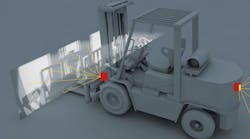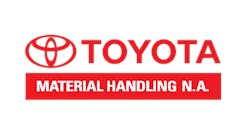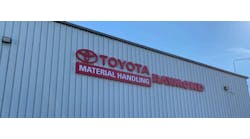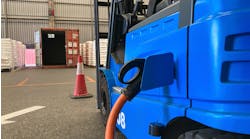Forklifts and automated guided vehicles are useful tools in factories and distribution facilities. With regard to worker safety, however, there are issues to keep in mind when using either manned or automated powered industrial vehicles. Occupational Safety and Health Administration (OSHA) states that someone gets killed every three days in a forklift accident, that almost 80% of the 110,000 annual forklift accidents involve a pedestrian and that it costs the U.S. over $135 million per year.
Besides workers' compensation or workers' lost time at the job, there are huge lawsuit awards made for forklift accidents. When you start adding up awards such as $750,000 for a back injury or $2.8 million for a foot injury, it's easy to see how these costs add up, given the number of incidents reported each year. These statistics are mainly due to humans walking or working near forklifts and who are not seen by the trained forklift operator.
Recent information about automated guided vehicle (AGV) accidents also demonstrates that even with onboard sensors these vehicles did not detect nearby workers. Further complications involving worker safety will happen as AGVs work in more unstructured environments and/or when robot arms are added (see figure 1).
These safety risks can be mitigated with the use of new technologies, such as three-dimensional sensors and algorithms that provide industrial vehicles with information about potential collisions in their paths.
However, the capabilities of these new sensors need to be well-characterized and their strengths and weaknesses need to be understood before they can be incorporated onto vehicles that are deployed on factory floors.
The National Institute of Standards and Technology (NIST) is working with industry and academia to provide technical foundations for strengthening and expanding the safety standards for industrial vehicles through the use of more advanced sensors and algorithms. NIST conducts experiments that provide data to support the development of test methods that augment safety standards for industrial vehicles. We describe some of our salient work in industrial vehicle safety standards in this article.
Toward Improving Worker Safety
In many forklift incidents, the driver's view was partially or fully blocked due to the forklift structure and load, environment occlusions, etc. Ideally, the forklift operator is alerted to a pedestrian being near the forklift. Many improvements to facilities and forklifts have been suggested and demonstrated to alert the driver to pedestrians or other nearby vehicles. These improvements included both persons who wear technology and forklifts and facilities embedded with technology to alert drivers and/or pedestrians. However, accidents continue to occur, simply because the driver does not see the pedestrian and therefore does not control the vehicle to avoid them.
Cameras and video monitors mounted on forklifts can help the driver "see" a pedestrian. However, each scene that the camera displays requires attention by the driver who many times is busy focusing on the task at hand. Keep in mind, cameras are not positioned in front of the load where they could see the vehicle path—for example in truck loading, load positioning, load retrieval/storage, etc.
Ideally, the forklift should be outfitted with human detection capability, even occluded humans, so when the driver does not see nearby workers, the vehicle would semi-autonomously slow or stop while not slowing or stopping the vehicle for every nearby obstacle.
Many AGVs have onboard two dimensional (2D) safety laser scanners used as virtual "bumpers" that are supposed to detect obstacles and pedestrians that are in the vehicle path and slow or stop the vehicle prior to contact with them. In many cases, several 2D laser scanners are mounted on the vehicle intending to detect obstacles throughout the contour area of the vehicle [ANSI/ITSDF B56.5-2012] since obstacles can also overhang the vehicle path. However, potential non-detection issues arise when using several 2D detection systems. Ideally, safety rated 3D imaging sensors are integrated onto the AGV and detect ground-based or overhanging obstacles, even predict when a person might enter the vehicle path.
Measurements and Test Methods
The Mobile Autonomous Vehicle Obstacle Detection/Avoidance (MAVODA) Project at the National Institute of Standards and Technology (NIST) has been researching methods to improve safety standards for AGVs, automated functions for manned powered industrial vehicles, and for forklift operator visibility. Measurements have been performed towards developing standard test methods for AGVs and semi-autonomous vehicles, such as forklifts with automated functions. Specifically, members of the MAVODA Project have been involved in the:
- American National Standards Institute/Industrial Truck Standards Development Foundation [ANSI/ITSDF B56.5-2012]Safety Standard for Guided Industrial Vehicles and Automated Functions of Manned Industrial Vehicles,
- [ANSI/ITSDF B56.11.6-2005] Evaluation of Visibility From Powered Industrial Trucks, and
- International Organization of Standards/Final Draft International Standard [ISO/FDIS 13564-1, 2012] Powered industrial trucks—Test methods for verification of visibility—Part 1: Sit-on and stand-on operator trucks up to and including 10-ton capacity.
The MAVODA Project has addressed specific areas of these three standards by developing test methods that could lead to improving these standards and to provide safe control of manufacturing vehicles, whether manned or unmanned. The following sections briefly describe project activities.
AGVs See in 2 and 3D
In 2010, NIST suggested improvements to the B56.5 standard including a new test piece, test piece coatings and non-contact sensor and vehicle performance requirements for detecting static test pieces in the vehicle path. The committee voted to accept these and other improvements and the standard was revised and published. However, the standard still includes an exception for obstacles suddenly appearing at less than the minimum AGV stopping distance.
The exception states: "Although the vehicle braking system may be performing correctly and as designed, it cannot be expected to function as designed should an object suddenly appear in the path of the vehicle and within the designed safe stopping distance. Examples include, but are not limited to, an object falling from overhead or a pedestrian stepping into the path of a vehicle at the last instant."
In experiments conducted in 2011 and 2012, NIST researchers used 2D and 3D imaging sensors mounted to an AGV. In contrast to the 2010 experiments where the test piece was static, in these experiments the AGV and the test piece were both moving. The test piece entered the AGV path, was detected by the safety sensors, and the distance of the test piece to the AGV and the AGV stopping distance during exception measurements were calculated and analyzed.
Giving Vehicles Some Autonomy
Forklifts that utilize an ideal semi-autonomous control to slow or stop the vehicle when the operator does not see a pedestrian would follow a similar AGV Grid-Video test method and would also be covered in B56.5. The MAVODA Project therefore, followed the same test method using a manned forklift. The 1.7 m/s maximum velocity forklift was outfitted with slowing control capability by simply removing acceleration and allowing the vehicle to coast to a stop when a standard test piece entered the vehicle path and was detected by an onboard safety laser scanner. The scanner, typically used on AGVs, was set to a detection range of 5 m in front of the vehicle which included a coasting distance of 4 m plus 1 m fork length.
The forklift-mounted sensor detected a static standard 70 mm diameter by 400 mm tall, flat black coated test piece when it was beyond the exception distance as B56.5 defines. The test piece, intended to represent a human leg, was also pushed within the forklift exception zone.
The onboard operator was also alerted with an onboard light when the safety sensor detected the test piece and could have braked to further reduce the vehicle's kinetic energy to not hit the test piece or steer to avoid it.
Forklifts See What Operators Can't
ANSI/ITSDF B56.11.6:2005 and ISO/FDIS 13564-1:2012 describe test methods that use a row of lights positioned where a forklift operator's head would be and shadows cast by the lights on a test board marked with a grid pattern. The shadows are equivalent to occluded regions and are quantified by counting the grid blocks. Occlusions are caused by vehicle obstructions. The current method shows that there are occluded regions, but does not specify their exact locations. Advanced imagers could then be mounted to detect obstacles/pedestrians in these occluded regions. The current light method provides only the direction having occluded regions and not the positions on the forklift where sensors might be mounted.
Advanced 3D imaging systems, for example stereo vision or laser or light detection and ranging sensors, along with high performance computers and software algorithms, can characterize the regions that are occluded from the operator's viewpoint more accurately than the light/shadow method. The MAVODA Project worked with Direct Dimensions, Inc. to measure a NIST-owned forklift and demonstrate the usefulness of the measurement as compared to the standard light method. The new test methods developed are being proposed to the B56.11.6 sub-committee.
NIST's Measurement Targets for 2013
In fiscal year 2013, the MAVODA Project plans to perform AGV and forklift measurements to develop standard test methods as follows:
- 3D sensor measurements used to detect only humans and control a vehicle to slow or stop appropriately;
- Perform measurements using radio frequency identification to predict when workers are occluded but near, and might enter the vehicle path;
- Perform force measurements of AGV bumpers to verify the B56.5 standard 135 N force applied to an obstacle or pedestrian to stop the vehicle prior to contacting the vehicle structure;
- Develop and propose a concept for an Automated Guided Vehicle Intelligence Level Performance Standard to incorporate safety and non-safety related performance metrics, such as AGV capabilities under various environmental, lighting, steering, flooring, tolerance, human interaction, and other conditions.
Roger Bostelman is engineering project manager in the Intelligent Systems Division at the National Institute of Standards and Technology. He is also a member of the Material Handling & Logistics Editorial Advisory Board.
References
ANSI/ITSDF B56.5: 2012 Safety Standard for Driverless, Automatic Guided Industrial Vehicles and Automated Functions of Manned Industrial Vehicles.
ANSI/ITSDF B56.11.6: 2005 Evaluation of Visibility from Powered Industrial Trucks
Austin, 2009 M. Austin, "Fork Lift Awareness," Presentation by Occupational Safety and Health Administration, Baltimore/Washington Office, 2009 Performance Metrics for Intelligent Systems Workshop (PerMIS '09), NIST Special Session, September 2009.
[Bostelman, 2009] R. Bostelman, "White Paper: Towards Improved Forklift Safety," Proceedings of the 2009 Performance Metrics for Intelligent Systems Workshop (PerMIS '09), NIST Special Publication 1112, September 2009.
[Bostelman, 2012] R. Bostelman, W. Shackleford, G. Cheok, K. Saidi, "Safe Control of Manufacturing Vehicles Research Towards Standard Test Methods," Progress in Material Handling Practice (Book Chapter), 2012.
[Hosier, 2009] F. Hosier, Worker fatally struck in head by forklift, http://www.safetynewsalert.com/worker-fatally-struck-in-head-by-forklift/ , December 2009
[ISO/FDIS 13564-1, 2012] Powered industrial trucks - Test methods for verification of visibility - Part 1: Sit-on and stand-on operator trucks up to and including 10 t capacity.
[Lawrence, 2001] K. Lawrence, Your Forklift Safety Zone, http://ohsonline.com/articles/2007/02/your-forklift-safety-zone.aspx, February 2001.
[Material Handling and Logistics, 2012] Death by AGV is a Tragic Surprise, http://mhlnews.com/blog/death-agv-tragic-surprise, August 2012
[NIOSH, 2011] Forklift Accident Statistics, http://www.chacha.com/question/how-many-forklift-accidents-occur-in-a-year, June 2011
[NIOSH, 1984] FACE 8418 - Fatal Accident Summary Report: Struck and Crushed By a Backing Forklift While Cleaning Up an Auto Salvage Yard, www.cdc.gov/niosh/face/In-house/full8418.html, 1984.
[NIOSH, 1995] FACE 9604 - Press Operator Dies After Forklift Rams Scrap Bin-- North Carolina, www.cdc.gov/niosh/face/In-house/full9604.html, 1995.
[OSHA, 2008] Accident: 201924669 - Employee Is Killed When Caught Between Forklift And Vehicle, http://www.osha.gov/pls/imis/accidentsearch.accident_detail?id=201924669, November 2008.




